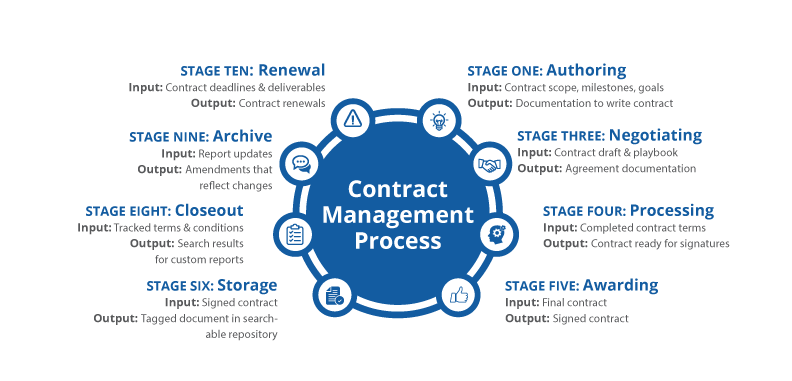Contract Lifecycle Management (CLM) usually comprises manually driven processes for document creation, management, approval, storage, renewals, and archival. In many cases, relevant documents only exist as hard copies in a file folder somewhere. They may even be stored off-site. Multiple versions of documents might live in various directories with no centralized policy for document retention and archiving.
The typical contract involves a lengthy process and requires input from numerous employees. As a result, there are many opportunities for mistakes.
Four instances of oversights that can forge significant financial and legal consequences are:
- There is a lack of consistent tracking of document versions, errors, and omissions. In this case, the organization risks fines, penalties, and even legal actions.
- The review and approval process is delayed. A setback affects the contractor, vendor, or employee in the agreement.
- There are price changes in the interim.
- The preferred vendor cannot perform the work after signing other contracts.
Let’s quickly review the steps for creating and managing contracts:

- Authoring is the step of creating the initial terms and conditions of the contract. The content is usually a mix of prewritten (sometimes generic) verbiage and new information contributed by multiple authors.
- Negotiating is where the agency and vendor make edits, fine-tune specifications, and prepare for performance periods.
- Processing is the act of tracking all revisions, versioning, and approvals.
- Awarding occurs after all stakeholders have agreed and approved the terms and conditions.
- Storage entails where the final documents are stored and shared for review.
- The last step will either be closeout or archive. This step depends on whether the contract is limited to a single term, renewal, and updates.
Content Services Platforms (CSP) like Laserfiche provide a complete, automated, cloud-based contract management system and removes the administrative burden and legal/regulatory headaches.
Here are benefits of Automated Contract Management:
- The standardized templates maintain compliance with legal or agency standards and empower the creation of better contracts.
- Authors can generate new contracts through an intuitive web-based form that pulls from a library of approved content and enforces proper formatting and construction.
- All contributors edit a single draft stored in the cloud.
- The system automatically tracks revisions to expedite the contract development process and eliminates confusion caused by multiple copies of the same document.
- E-signatures and email reminders make it easy for all parties to sign off on changes.
- A contract dashboard allows users to see all tasks, including approvals and their status.
- The comprehensive search features make finding specific text easy and resolving disputes faster. Authors can search for the best fit out of multiple vendors based on price and capabilities.
- Automated alerts can help ensure that your organization complies with payments and renewal dates to avoid late fees and other penalties with awarded contracts.
- Secure document storage and archival ensures that sensitive data does not fall into the wrong hands.
Finally, by automating and speeding up the contract development, approval, and awarding processes, organizations benefit from a variety of cost savings, including:
- Faster negotiations and improved contract terms
- Improved tracking of contract deliverables
- Elimination of late fees or unwanted auto-renewals
- Employees who are subject matter experts are freed up for their primary roles
- Syncing contract information with accounting and finance departments
Learn how we can streamline the entire lifecycle of contracts, from internal contract requests to final signatures.






